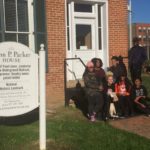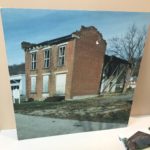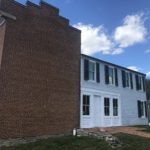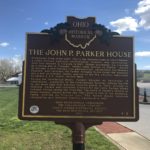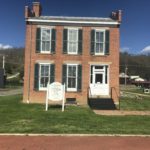Photo and story by Jarron Parker / Contributing Writer
Four MTSU professors and 14 students traveled to Ripley and Cincinnati, Ohio, to visit museums focused on the institution of slavery in the US this past weekend.
After a five-hour drive, the two buses arrived at a two-story brick house right on the Ohio River that once belonged to John P. Parker, an African-American slave turned abolitionist. It’s now a designated national landmark that served as a safe house for the Underground Railroad. Runaways would escape from bordering Kentucky by crossing the Ohio River into the free state of Ohio. Dewey, the only worker on duty, recounted the triumphant history of Parker who was the child of a biracial slave and a white man presumed to be her owner. Parker was able to buy his freedom after being subleased to a foundry by his owner.
“John was able to pay 1,800 dollars in it’s entirety after a year and half,” said Dewey. He noted that this was when it cost a family of four only $5 a month to survive. After buying his freedom, Parker worked as an iron molder and inventor being one of six African-Americans to receive a patent in the 1800s; the 1890 census listed Parker as the eighth wealthiest person in Ripley. Parker married Miranda Boulden, and the two had six children, all of which went on to be college-educated. Although his greatest accomplishments would be his “rescuing of some 600-900 slaves in his time” explained Dewey.
The next stop was less than half a mile away and sat alone atop the rolling hills of Ripley overlooking the John P. Parker house, the Ohio River and into neighboring Kentucky: the home of abolitionist John Rankin. Although the home was closed for visitors for the day, the history of determination and hardship that runaways went through to reach the house that sits on the steep hillside to reach freedom was obvious. The only way to reach the house during that time would have been to scale the steep and challenging terrain, which made clear the endurance and perseverance runaway slaves would have had to have.
The National Underground Railroad Freedom Center served as the final museum on the trip. The tour, led by Eileen, who’s been at the museum since its opening almost 15 years ago, showed the history of America’s practice of African and African-American slavery. The tour consisted of moving through the timeline of Africans being torn from their native land and ended with African-American experiences up until the late 1800s. Eileen shared the heart-wrenching story of slave Margaret Garner who made it to freedom in Ohio but later faced US Marshals for being a fugitive slave. Garner refused to see her children returned to slavery, so she killed her daughter and was stopped before she could do the same to her remaining three children.
“This is one story that I rarely get through without tearing up, and this is one case that shows the terrible effects of the horrible system of slavery,” said Eileen.
The museum’s largest artifact is a slave pen built in 1830 by slave trader John Anderson. The pen’s purpose was to hold people waiting to be sold on the auction block in various southern states. Of all things in the museum, one fact that resonated the most and hit closest to home for the group of students and professors regarded the plantation of Isaac Franklin, America’s largest slave dealer, who built a plantation right outside of Nashville. The plantation is now being renovated into a luxury golf course with the 500-square feet slave huts serving as a bed-and-breakfast. Wealthy people will be paying big bucks to play golf, rest and relax on the same land that that once held families captive and waiting for their freedom to be auctioned off, separating them from their families.
Although there are numerous museums in Ripley and Cincinnati, these three were poignant examples of what a history Africans and African-Americans have with overcoming hardships and inhumane conditions in an attempt to create better situations for those who came after them.
To contact Lifestyles Editor Marissa Gaston email lifestyles@mtsusidelines.com.
For more updates, follow us at www.mtsusidelines.com, on Facebook at MTSU Sidelines and on Twitter/Instagram at @Sidelines_Life.




